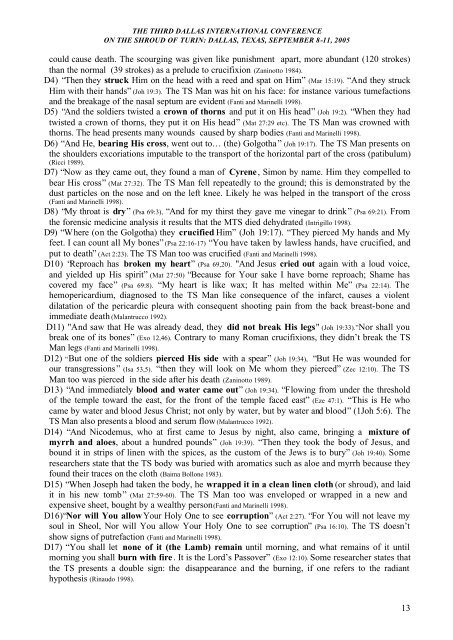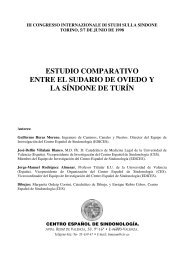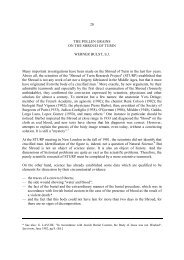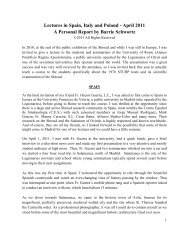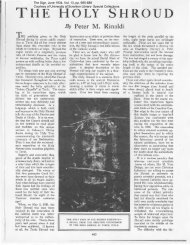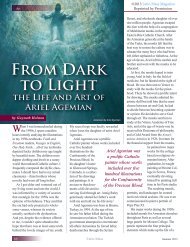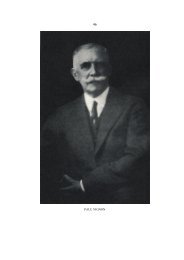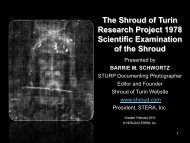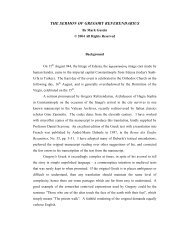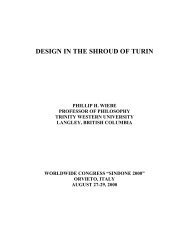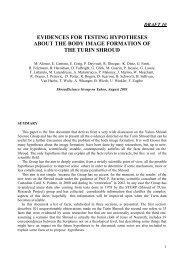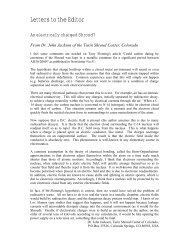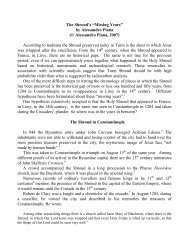Evidences for Testing Hypotheses about the Body Image Formation ...
Evidences for Testing Hypotheses about the Body Image Formation ...
Evidences for Testing Hypotheses about the Body Image Formation ...
Create successful ePaper yourself
Turn your PDF publications into a flip-book with our unique Google optimized e-Paper software.
THE THIRD DALLAS INTERNATIONAL CONFERENCEON THE SHROUD OF TURIN: DALLAS, TEXAS, SEPTEMBER 8-11, 2005could cause death. The scourging was given like punishment apart, more abundant (120 strokes)than <strong>the</strong> normal (39 strokes) as a prelude to crucifixion (Zaninotto 1984).D4) “Then <strong>the</strong>y struck Him on <strong>the</strong> head with a reed and spat on Him” (Mar 15:19). “And <strong>the</strong>y struckHim with <strong>the</strong>ir hands” (Joh 19:3). The TS Man was hit on his face: <strong>for</strong> instance various tumefactionsand <strong>the</strong> breakage of <strong>the</strong> nasal septum are evident (Fanti and Marinelli 1998).D5) “And <strong>the</strong> soldiers twisted a crown of thorns and put it on His head” (Joh 19:2). “When <strong>the</strong>y hadtwisted a crown of thorns, <strong>the</strong>y put it on His head” (Mat 27:29 etc). The TS Man was crowned withthorns. The head presents many wounds caused by sharp bodies (Fanti and Marinelli 1998).D6) “And He, bearing His cross, went out to… (<strong>the</strong>) Golgotha” (Joh 19:17). The TS Man presents on<strong>the</strong> shoulders excoriations imputable to <strong>the</strong> transport of <strong>the</strong> horizontal part of <strong>the</strong> cross (patibulum)(Ricci 1989).D7) “Now as <strong>the</strong>y came out, <strong>the</strong>y found a man of Cyrene, Simon by name. Him <strong>the</strong>y compelled tobear His cross” (Mat 27:32). The TS Man fell repeatedly to <strong>the</strong> ground; this is demonstrated by <strong>the</strong>dust particles on <strong>the</strong> nose and on <strong>the</strong> left knee. Likely he was helped in <strong>the</strong> transport of <strong>the</strong> cross(Fanti and Marinelli 1998).D8) “My throat is dry” (Psa 69:3), “And <strong>for</strong> my thirst <strong>the</strong>y gave me vinegar to drink” (Psa 69:21). From<strong>the</strong> <strong>for</strong>ensic medicine analysis it results that <strong>the</strong> MTS died dehydrated (Intrigillo 1998).D9) “Where (on <strong>the</strong> Golgotha) <strong>the</strong>y crucified Him” (Joh 19:17). “They pierced My hands and Myfeet. I can count all My bones” (Psa 22:16-17) “You have taken by lawless hands, have crucified, andput to death” (Act 2:23). The TS Man too was crucified (Fanti and Marinelli 1998).D10) “Reproach has broken my heart” (Psa 69,20). "And Jesus cried out again with a loud voice,and yielded up His spirit” (Mat 27:50) “Because <strong>for</strong> Your sake I have borne reproach; Shame hascovered my face” (Psa 69:8). “My heart is like wax; It has melted within Me” (Psa 22:14). Thehemopericardium, diagnosed to <strong>the</strong> TS Man like consequence of <strong>the</strong> infarct, causes a violentdilatation of <strong>the</strong> pericardic pleura with consequent shooting pain from <strong>the</strong> back breast-bone andimmediate death (Malantrucco 1992).D11) "And saw that He was already dead, <strong>the</strong>y did not break His legs" (Joh 19:33).”Nor shall youbreak one of its bones” (Exo 12,46). Contrary to many Roman crucifixions, <strong>the</strong>y didn’t break <strong>the</strong> TSMan legs (Fanti and Marinelli 1998).D12) “But one of <strong>the</strong> soldiers pierced His side with a spear” (Joh 19:34), “But He was wounded <strong>for</strong>our transgressions” (Isa 53,5). “<strong>the</strong>n <strong>the</strong>y will look on Me whom <strong>the</strong>y pierced” (Zec 12:10). The TSMan too was pierced in <strong>the</strong> side after his death (Zaninotto 1989).D13) “And immediately blood and water came out” (Joh 19:34). “Flowing from under <strong>the</strong> thresholdof <strong>the</strong> temple toward <strong>the</strong> east, <strong>for</strong> <strong>the</strong> front of <strong>the</strong> temple faced east” (Eze 47:1). “This is He whocame by water and blood Jesus Christ; not only by water, but by water and blood” (1Joh 5:6). TheTS Man also presents a blood and serum flow (Malantrucco 1992).D14) “And Nicodemus, who at first came to Jesus by night, also came, bringing a mixture ofmyrrh and aloes, <strong>about</strong> a hundred pounds” (Joh 19:39). “Then <strong>the</strong>y took <strong>the</strong> body of Jesus, andbound it in strips of linen with <strong>the</strong> spices, as <strong>the</strong> custom of <strong>the</strong> Jews is to bury” (Joh 19:40). Someresearchers state that <strong>the</strong> TS body was buried with aromatics such as aloe and myrrh because <strong>the</strong>yfound <strong>the</strong>ir traces on <strong>the</strong> cloth (Baima Bollone 1983).D15) “When Joseph had taken <strong>the</strong> body, he wrapped it in a clean linen cloth (or shroud), and laidit in his new tomb” (Mat 27:59-60). The TS Man too was enveloped or wrapped in a new andexpensive sheet, bought by a wealthy person (Fanti and Marinelli 1998).D16)“Nor will You allow Your Holy One to see corruption” (Act 2:27). “For You will not leave mysoul in Sheol, Nor will You allow Your Holy One to see corruption” (Psa 16:10). The TS doesn’tshow signs of putrefaction (Fanti and Marinelli 1998).D17) “You shall let none of it (<strong>the</strong> Lamb) remain until morning, and what remains of it untilmorning you shall burn with fire. It is <strong>the</strong> Lord’s Passover” (Exo 12:10). Some researcher states that<strong>the</strong> TS presents a double sign: <strong>the</strong> disappearance and <strong>the</strong> burning, if one refers to <strong>the</strong> radianthypo<strong>the</strong>sis (Rinaudo 1998).13


